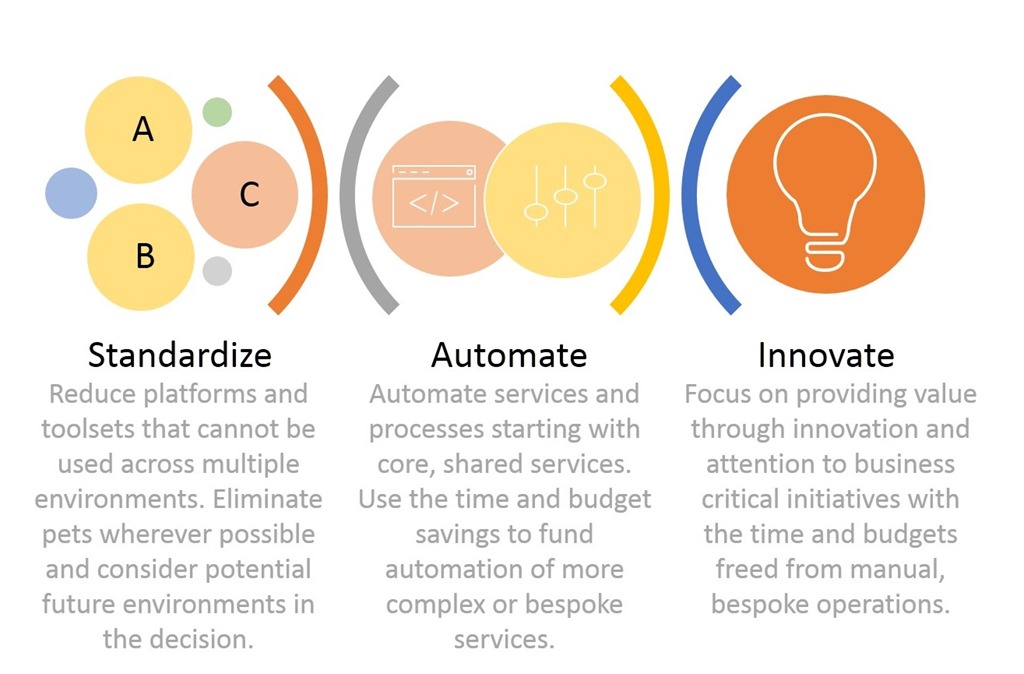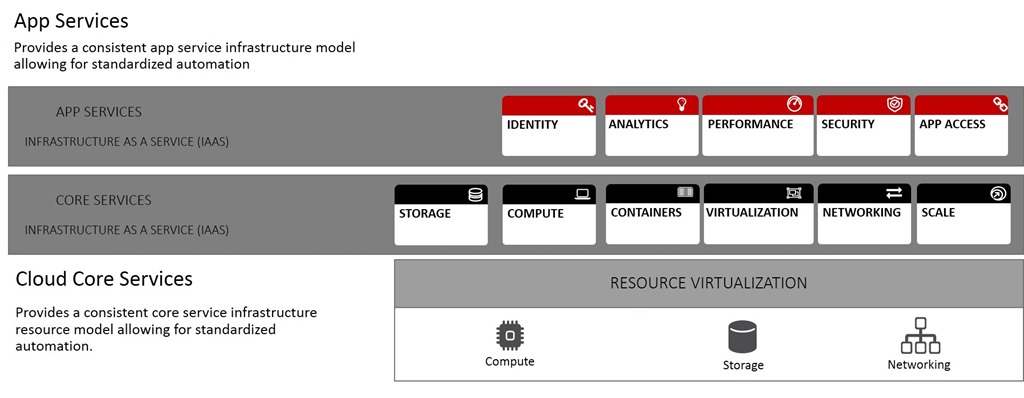멀티 클라우드에서 승리하는 방법: 표준화 후 자동화로 혁신을 이루세요
클라우드는 언제나 규모의 경제를 실현하는 데 중점을 두었습니다. 디지털 혁신으로 인해 조직에서는 애플리케이션을 통해 생산성(내부)과 수익(외부)을 개선할 수 있는 새로운 기회를 모색하게 되었고, 이에 따라 운영과 앱의 확장 속도가 기하급수적으로 증가했습니다. 기존의 수동 방식으로는 앱의 수와 업데이트 및 개선 빈도를 관리할 수 없게 됐습니다. 앱과 운영을 확장하는 데 있어 인간의 병목 현상이 발생했습니다. 우리는 더 이상 문제에 더 많은 사람을 투입하고 같은 결과를 기대할 수 없습니다. 애플리케이션당 비용(사용자당, 고객당, 거래당)은 수익과 비용 절감을 통해 달성되는 것보다 훨씬 빠르게 증가합니다. 이런 불균형으로 인해 과거와 같은 방식으로 애플리케이션을 제공하는 것은 비현실적입니다.
클라우드는 표준화의 힘을 도입함으로써 그 방정식을 바꿀 것이라고 항상 약속해 왔습니다. 이는 동일한 화이트박스 서버의 정확한 사본으로 랙을 채우는 것만이 아니라 운영을 표준화하는 것입니다. 퍼블릭 클라우드는 운영이 리소스와 상호 작용할 수 있는 표준화된 플랫폼을 제공함으로써 이를 달성합니다. 이러한 공통적인 핵심 리소스(서비스)인 컴퓨팅, 네트워크, 스토리지의 프로비저닝과 관리를 표준화함으로써 자동화(즉, DevOps)를 적용할 수 있으며 더 높은 규모의 경제를 달성할 수 있습니다.
하지만 애플리케이션에는 공통적인 핵심 서비스 이상의 것이 필요합니다. 앱은 더 빠르고 안전해야 하며, 이는 보안 및 성능과 같이 앱에 필요한 맞춤형 서비스를 제공하는 방법에 대해 더 스마트해지는 것을 의미합니다.

표준화 후 자동화로 혁신을 이루세요
앱은 공통적인 보안 및 성능 요구 사항을 공유할 수 있지만, 공통적인 것만으로는 오늘날 소비자가 요구하는 앱을 보호하고 추진하기에 충분하지 않을 수 있습니다. 그들에게는 플랫폼 및 프로토콜 수준의 공격으로부터 보호하는 것 외에도 표준 보안이 필요합니다. 그들은 비밀번호 입력과 보고서 작성에 소요되는 시간을 절약하여 가치를 더하는 긍정적인 성과 개선이 필요합니다.
하지만 먼저 표준화하지 않았다면 맞춤형 장식이나 사용자 정의 구성을 위한 시간이 없을 것입니다. 온프레미스든 오프프레미스든 클라우드는 그렇습니다. 클라우드는 경쟁 우위를 확보하고 빠르고 안전한 앱을 통해 소비자에게 기쁨을 제공하는 데 필요한 관심을 확보하기 위한 첫 번째 단계입니다.
하지만 모든 앱이 모든 클라우드 환경에 적합한 것은 아닙니다. 어떤 사람들은 기업 환경의 편안함과 안정감을 원합니다. 다른 사람들은 공공 클라우드인 공공 장소에 있어야만 성공할 수 있습니다. 이는 멀티 클라우드 전략과 구현, 그리고 이를 실현하는 데 도움이 되는 새로운 환경(예: 콜로케이션 및 상호 연결)이 늘어나는 이유 중 하나입니다. 왜냐하면 우리가 항상 "직무에 적합한 도구"라는 전제 하에 운영해 왔듯이 오늘날 디지털 대응물은 "직무에 적합한 클라우드"이기 때문입니다.
멀티 클라우드 전략을 채택하면 표준화가 더 어려워집니다. 각 환경은 자체적으로는 표준화될 수 있지만, 다른 환경과는 표준화될 수 없습니다. 도구와 프레임워크는 오프프레미스 배포를 관리하는 운영자에게 "표준 인터페이스" 계층을 제공하여 이러한 과제를 해결하는 데 도움이 됩니다. 이는 눈송이처럼 다양한 클라우드가 존재하는 세상에서 표준화를 가능하게 하는 운영 계층입니다.
규모의 경제를 달성하는 데 필요한 공통적이고 핵심적인 서비스를 표준화한 후에는 보안 과 보호 기능을 제공하는 앱 서비스와 소비자의 참여를 유지하는 데 필요한 긍정적인 성과를 고려해야 합니다. 데이터 센터 중단의 원인 중 시스템 공격이 가장 빠르게 증가하고 있는 것으로 나타났으며 , 2010년 중단의 2%에서 22%로 증가했습니다. 클라우드에 있는 앱을 직접 공격해도 데이터 센터는 더 이상 무너지지 않을지 몰라도, 브랜드와 긴밀하게 연결된 앱을 공격하면 평판과 수익에 치명적일 수 있습니다.
여기에서도 동일한 전략이 필요합니다. 앱 서비스를 만들고, 배포하고, 관리하는 담당자와 아키텍트에게 표준 "운영 인터페이스"를 제공하는 플랫폼을 사용해야 합니다. 이 표준 인터페이스는 공통 핵심 서비스에 사용하는 도구와 프레임워크와 동일한 종류의 앱 서비스 운영 계층을 제공합니다.

표준화가 완료되고 공유 운영 인터페이스가 구축되면 자동화가 가능합니다. 공통적이고 공유되는 서비스와 프로세스를 먼저 자동화한 다음, 이를 통해 절감된 시간과 예산을 활용해 보다 진보적이고 맞춤형 서비스와 프로세스를 개발하면 큰 이익을 얻을 수 있습니다. 여기에서 공통적인 운영 인터페이스(운영 계층)는 스크립트와 코드의 재사용을 장려하고 기존 기술을 활용하여 하루에 여러 번 코드를 커밋하고 더 자주 배포를 기대하는 개발자와 동등한 수준을 실현하는 데 필요한 자동화 수준을 달성함으로써 성과를 거두고 있습니다.
자동화는 규모의 경제성을 개선하고 결과의 변동을 줄이는 비결입니다(실제로는 "프로세스의 결함과 오류 제거"를 의미하는 Six Sigma/Lean 용어입니다). 연구에 따르면 정전의 약 22%는 인간의 실수로 인해 발생한다고 합니다. 그리고 다른 연구에 따르면 IT 부서는 시간의 약 15.9%를 문제 해결과 수정에 사용하며, 이 중 일부는 인간의 실수에서 비롯될 가능성이 높습니다. 자동화는 IT가 프로비저닝, 업데이트, 패치 및 구성 관리에 집중하는 부분을 상당 부분 줄일 뿐만 아니라 오류 수와 오류를 찾고 수정하는 데 소요되는 시간을 줄여 시간을 절약할 수 있습니다.
마침내 혁신에 집중할 수 있는 충분한 시간과 예산을 확보하게 되었습니다. 비즈니스 관련 아이디어 창출 세션에 보다 적극적으로 참여하는 것이든, IT를 최적화하기 위한 새로운 기회를 찾는 것이든, 모두 혁신입니다. 그리고 이 모든 것은 자동화를 통해 가능해졌으며, 표준화된 시스템에 적용되었을 때만 진정한 효과를 발휘합니다.
이는 새로운 것이 아닙니다. 조립 라인과 자동화는 100년 이상 절실히 필요한 규모의 경제를 제공해 왔습니다. 그리고 그들은 모두 시간과 비용 절감을 달성하여 혁신하기 위해 표준화와 자동화라는 동일한 단계부터 시작합니다. 자동화를 최적화하여 더 큰 이점을 실현할 수 있는 기술과 흑마법의 달인은 많이 있지만, 거기에 도달하기 전에 먼저 표준화가 필요합니다.
IT의 경우, 오프프레미스와 온프레미스, 클라우드와 기존 인프라를 포함한 모든 자산에서 사용하는 도구, 프레임워크, 플랫폼을 살펴보고 표준화하여 혁신을 위한 자동화를 시작할 수 있다는 의미입니다.
